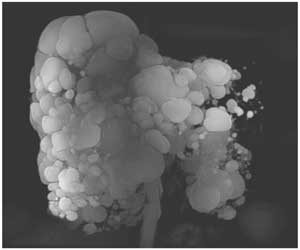- Home
- Editorial
- News
- Practice Guidelines
- Anesthesiology Guidelines
- Cancer Guidelines
- Cardiac Sciences Guidelines
- Critical Care Guidelines
- Dentistry Guidelines
- Dermatology Guidelines
- Diabetes and Endo Guidelines
- Diagnostics Guidelines
- ENT Guidelines
- Featured Practice Guidelines
- Gastroenterology Guidelines
- Geriatrics Guidelines
- Medicine Guidelines
- Nephrology Guidelines
- Neurosciences Guidelines
- Obs and Gynae Guidelines
- Ophthalmology Guidelines
- Orthopaedics Guidelines
- Paediatrics Guidelines
- Psychiatry Guidelines
- Pulmonology Guidelines
- Radiology Guidelines
- Surgery Guidelines
- Urology Guidelines
Case of Liver Involvement in Polycystic Kidney Disease reported in NEJM

Dr Mehmet E. Adin at Tatvan Can Hospital, Bitlis, Turkey have reported a rare case of Liver Involvement in Autosomal Dominant Polycystic Kidney Disease. The case has appeared in the New England Journal of Medicine.
Liver involvement is the most frequent extrarenal manifestation in autosomal-dominant polycystic kidney disease (ADPKD). Liver cysts are responsible for most hepatic complications, but other liver changes may occasionally be encountered, including congenital hepatic fibrosis and segmental dilation of the biliary tract. It has become more prevalent as a result of increased life expectancy, improved renal survival, reduced cardiovascular mortality, and renal replacement therapy.
According to history, a 51-year-old woman with autosomal dominant polycystic kidney disease presented to the primary care clinic with mild worsening of chronic abdominal pain. No jaundice was found on physical examination; the liver was enlarged, and the patient had mild tenderness in the right upper quadrant and in the flanks on both sides. Murphy’s sign was absent.
Her Laboratory findings showed mildly elevated levels of aspartate aminotransferase and alanine aminotransferase. Innumerable cysts were found on abdominal ultrasonography; the gallbladder could not be visualized. Magnetic resonance cholangiopancreatography was performed and revealed a markedly enlarged liver with numerous cystic structures (a three-dimensional maximum-intensity-projection reconstruction is shown in the figure). No signs of intracystic hemorrhage, rupture, or infection were found; the presentation was not consistent with acute cholecystitis.
In autosomal dominant polycystic kidney disease, cysts can develop in a range of sites, including the liver, pancreas, and seminal vesicles. The patient was treated with intravenous hydration and analgesia, and the pain decreased. At a 1-year follow-up visit, no additional complications or new symptoms had developed. The patient continued to have occasional abdominal pain.
Studies have found that women with ADPKD are at the higher relative risk of a liver complication than men, but the reverse was observed for the positive association between ADPKD and biliary tract disease, suggesting that liver and biliary complications of ADPKD have distinct disease mechanisms.
For more details click on the link: DOI: 10.1056/NEJMicm1809242

Disclaimer: This site is primarily intended for healthcare professionals. Any content/information on this website does not replace the advice of medical and/or health professionals and should not be construed as medical/diagnostic advice/endorsement or prescription. Use of this site is subject to our terms of use, privacy policy, advertisement policy. © 2020 Minerva Medical Treatment Pvt Ltd